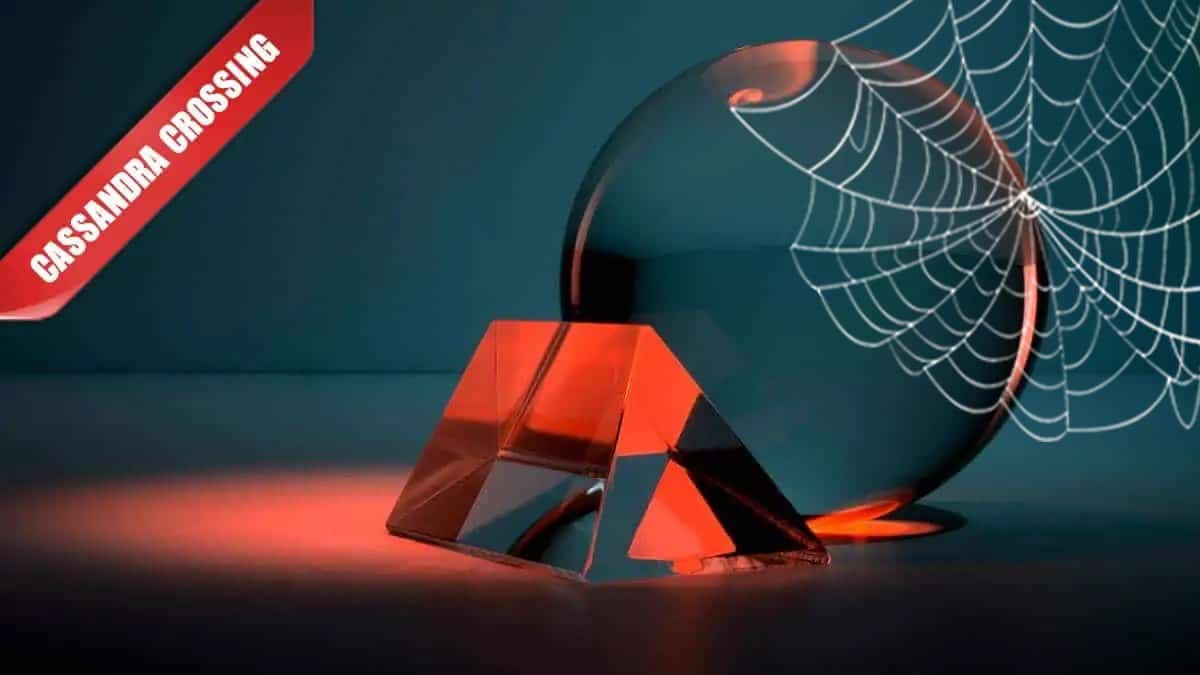This is a text automatically translated from Italian. If you appreciate our work and if you like reading it in your language, consider a donation to allow us to continue doing it and improving it.
The articles of Cassandra Crossing I'm under license CC BY-SA 4.0 | Cassandra Crossing is a column created by Marco Calamari with the "nom de plume" of Cassandra, born in 2005.
A (vintage) sequel to a de The unbearable unreliability of the bit!
This article was written on April 9, 2009 from Cassandra
Cassandra Crossing 146/ The (im)mortal unreliability of bits
The number ends with the expert trying to move the cursor by swiping the mouse on a vertical wall of the totem (with the axes swapped) and taking tens of seconds to click OK.
Cassandra's most loyal patrons will remember The unbearable unreliability of bits, a funny but very serious episode released a couple of years ago. You know, I know some people, friends and capable IT professionals, who still maintain that information systems evolve and improve over time to provide new services and new functions; really, they say it seriously, they don't even laugh a little. I wish they had come to the bank with me on Friday.
In fact, immediately before the holidays, needing some of the hard-earned, healthy, anonymous (and therefore reviled) cash, I popped into the bank, a primary and very serious credit institution which was the subject, like so many these days, of a recent merger.
One of the innovative services created after the merger is the machine that issues queue numbers. A small gray sheet metal totem with a touch screen, a slot for a printer and a slot for a smartcard reader.
It is this smartcard that innovates the service compared to the economical and very reliable roll of numbered coupons that any grocer has been using for decades. In fact, the screen only shows two large buttons; with one you get a number, with the other you get a "privileged" number if you insert your loyal customer card first.
I am a long-time customer but also paranoid, so I was careful not to ask for the card and I willingly resign myself to the slowest queue. On Friday, however, the totem showed something different.
The bright screen of the totem, just by touching the button, promptly showed the cursor of a non-existent mouse and opened a window with a message. And I, who only wanted the little number, moreover plebeian. I
The message in the open window was a broadcast from a system address, admonishing all cashiers to close their counters an hour early to close the accounts early, as it was a day before a holiday.
The window, obviously modal, was accompanied by an artistic "Click to exit" button to be clicked with the non-existent mouse. Gestures such as the tap or double tap with the finger were not foreseen, and therefore the plebeian number button lay sadly in the background, untouchable like a mirage!
Giggling under my mustache (yes, I have one) I approached a gruff cashier, and with the most leaden face I could muster I tried to explain the situation to him; since he didn't understand anything, I then summarized with a much simpler, although less detailed "the machine doesn't work".
Then I sadistically sat in an armchair in front of the totem to enjoy the scene.
The cashier arrives and, after having fiddled with the touch screen, which only allowed you to move the cursor, finally realizes that he cannot click; he then goes away in search of help.
The expert arrives with the key to open the base of the totem; the usual low-cost PC appears, equipped with the usual widespread operating system, but characterized by the absence of both the mouse and the keyboard.
Another round, another run and this time two of them arrive with a keyboard, which, however, once connected is not recognised; still no Return to crush.
After further confabulation, the second man goes to his PC, unplugs the USB mouse, plugs it into the socket and miracle, the mouse is recognized and works.
The artistic computer science issue ends with some acrobatics of the expert who tries to move the cursor by swiping the mouse on a vertical wall of the totem (with the axes swapped) and takes several tens of seconds to reach the coveted "OK" button.
Dismantling, locking of the totem, end of the show, no applause from the audience.
“That's all?” - someone will say -It wasn't as interesting or even as entertaining as the previous episode.”
Be careful though: the number of clowns I have described is just the tip of the iceberg; in fact all the actors in this show were respectable accounting and administrative professionals of a totally computerized world like that of a bank. But in banks, and in many other computerized realities, any trace of pre-existing computer skills has been carefully removed due to the demotivation of the users and from wild outsourcing.
It couldn't be otherwise.
The totem was obviously poorly designed just like any simple system made with a complex but cheap system like a PC, just like the already mentioned signs of railway stations.
Since the totem is a PC, due to the merger between banks and the chaos generated by the related merger of information systems, some underpaid temporary employee of a temporary agency has probably included it in the list of cashiers' PCs, or has decided to use a network broadcast message to warn them, regardless (ignorant?) of the fact that the message would also reach unattended PCs.
In short, in this information system (certainly no worse than others) the head that had to think about it in the planning phase was missing, the hands that were supposed to do the right thing were missing, and luckily there were at least the legs that, albeit in a shaky and uncertain, they at least restored the distribution of coupons, in mine and in all the other branches of the banking group.
End of the second episode; This confirms the fact that we cannot afford to spread unnecessary complexity into computer systems, otherwise the next window may appear on my MRI scan or Perhaps open on the touch screen of the defibrillator in a recovery room, and I greet you.
We should be happy that the medical systems that have to save lives are (for a little longer) isolated and that the real banking systems, the ones that move our money, are still the mainframes (perhaps emulated) of 30 years ago with the programs written in Cobol by retired or deceased programmers.
But this "rosy" and safe situation will not last; integration and cost reduction are advancing inexorably and will also make these systems unnecessarily complex and therefore unreliable, just like this anti-aircraft battery which a year ago wiped out not enemy planes but all its gunners in a matter of seconds.
Stay alert! Then don't say I didn't tell you.
Marco Calamari

Video column “A chat with Cassandra”
Cassandra's Slog (Static Blog).
Cassandra's archive: school, training and thought
Join communities
If you have found errors in the article you can report them by clicking here, Thank you!







